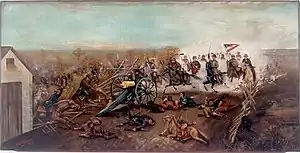Battle of Byram's Ford
The Battle of Byram's Ford, officially known as the Action at the Big Blue, Mo., was a minor engagement of the American Civil War, comprising two separate skirmishes from October 22 to 23, 1864, in Jackson County, Missouri. It formed a part of the larger Battle of Westport, which ultimately resulted in a Union victory and the end of all major Confederate operations in Missouri.
| Battle of Byram's Ford | |||||||
|---|---|---|---|---|---|---|---|
| Part of the Trans-Mississippi Theater of the American Civil War | |||||||
 The Battle of the Blue by Benjamin D. Mileham | |||||||
| |||||||
| Belligerents | |||||||
|
|
| ||||||
| Commanders and leaders | |||||||
|
Maj. Gen. James G. Blunt Maj. Gen. Alfred Pleasonton |
| ||||||
| Units involved | |||||||
|
First Division, Army of the Border Pleasanton's Cavalry Division | Shelby's and Marmaduke's divisions | ||||||
Background
Confederate Major-General Sterling Price's Army of Missouri was headed westward towards Kansas City and Fort Leavenworth, hoping to capture Missouri for the South and negatively influence Abraham Lincoln's chances for reelection in 1864. Union Major-General Samuel R. Curtis's Army of the Border, in and around Westport, was blocking the Confederates' way west, while Major-General Alfred Pleasonton's provisional cavalry division was pressing Price's rear. Price had nearly 500 wagons with him, and required a good ford over the Blue River to facilitate passage of his supplies. Byram's Ford was the best crossing in the area, and would clearly be a point of great strategic significance during the impending Battle of Westport.
First engagement, October 22


On October 22, Major-General James G. Blunt's division held a defensive position on the west bank of the Big Blue River. Around 10 a.m., part of Brigadier-General Joseph O. Shelby's Confederate division conducted a frontal attack on Blunt's men. This attack was a ruse, because the rest of Shelby's men flanked Blunt's hasty defenses, forcing the Federals to retire to Westport. Price's wagon train then crossed the Big Blue River at Byram's Ford and headed south to the village of Little Santa Fe and safety.
Second engagement, October 23
The Battle of Westport began in earnest on the morning of the October 23. Pleasonton's cavalry was hot on the tail of Price's army, having engaged his rear guard in nearby Independence the previous day. Brigadier-General John S. Marmaduke's Confederate division had stopped Pleasonton just west of Independence, and now held the west bank of the Big Blue at Byram's Ford to protect Price's rear from an expected Union attack.
Pleasonton began his assault on Byram's Ford around 8 a.m. Initially the Confederates held their own. One of the Union brigade commanders, Brigadier-General Egbert B. Brown, stalled his attack and was placed under arrest by Pleasonton for disobeying orders. Another of Pleasonton's brigade commanders, Col. Edward F. Winslow, was wounded and succeeded by Lieutenant-Colonel Frederick Benteen, who later rode to fame at the Little Bighorn. Despite these setbacks, Federal troopers gained the west bank by 11 a.m. and Marmaduke retired. As Brown's brigade (now led by Cololonel John F. Philips) forded the river, they came under heavy fire from Confederate artillery. Once they had crossed, they charged Marmaduke across an open field; during this charge, Union troops from Missouri and Arkansas battled Confederates from these same two states. As Marmaduke rejoined Shelby and Fagan, Blunt pounded the consolidated Confederate forces with his own cannon, completing Pleasonton's victory at Byram's Ford and contributing significantly to Curtis's larger triumph at Westport.
Aftermath
With Pleasonton now across the river he was now an additional threat to Price, who was heavily engaged with Curtis's main force at Westport. Defeated by Curtis there and menaced by Pleasonton and an additional Federal brigade under John McNeil, Price had to abandon his Missouri campaign and retreat southward. This brought to a close the last major Confederate military operation west of the Mississippi River, and ended the last major Southern threat to any Northern state.[1]
Battlefield preservation
The Civil War Trust (a division of the American Battlefield Trust) and its partners have acquired and preserved 39 acres (0.16 km2) of the Byram's Ford battlefield.[2]
References
- U.S. National Park Service CWSAC Battle Summary
- American Battlefield Trust "Saved Land" webpage. Accessed May 23, 2018.
